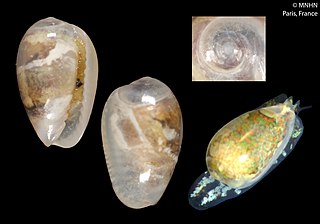
Bivalvia, in previous centuries referred to as the Lamellibranchiata and Pelecypoda, is a class of marine and freshwater molluscs that have laterally compressed bodies enclosed by a shell consisting of two hinged parts. Bivalves as a group have no head and they lack some usual molluscan organs like the radula and the odontophore. They include the clams, oysters, cockles, mussels, scallops, and numerous other families that live in saltwater, as well as a number of families that live in freshwater. The majority are filter feeders. The gills have evolved into ctenidia, specialised organs for feeding and breathing. Most bivalves bury themselves in sediment where they are relatively safe from predation. Others lie on the sea floor or attach themselves to rocks or other hard surfaces. Some bivalves, such as the scallops and file shells, can swim. The shipworms bore into wood, clay, or stone and live inside these substances.

Spondylus is a genus of bivalve molluscs, the only genus in the family Spondylidae. They are known in English as spiny oysters.

Clam shrimp are a group of bivalved branchiopod crustaceans that resemble the unrelated bivalved molluscs. They are extant and also known from the fossil record, from at least the Devonian period and perhaps before. They were originally classified in the former order Conchostraca, which later proved to be paraphyletic and was subsumed into the superorder Diplostraca. Clam shrimp now make up three of the seven orders in Diplostraca, Cyclestherida, Laevicaudata, and Spinicaudata, in addition to the fossil family Leaiidae.

Ostrea is a genus of edible oysters, marine bivalve mollusks in the family Ostreidae, the oysters.

Ostrea edulis, commonly known as the European flat oyster, is a species of oyster native to Europe. In Britain and Ireland, regional names include Colchester native oyster, mud oyster, or edible oyster. In France, Ostrea edulis are known as huîtres plates except for those that come from the Belon River estuary in Brittany, France, which are known as Belons.

Gibberula is a genus of minute sea snail, a marine gastropod mollusk or micromollusk in the family Cystiscidae, previously placed in the family Marginellidae, the margin shells or marginellids.

The Gryphaeidae, common name the foam oysters or honeycomb oysters, are a family of marine bivalve mollusks, and are a kind of true oyster. This family of bivalves is very well represented in the fossil record, however the number of living species is very few.

Atrypa is a genus of brachiopod with shells round to short egg-shaped, covered with many fine radial ridges, that split further out and growthlines perpendicular to the costae and 2-3 times wider spaced. The pedunculate valve is a little convex, but tends to level out or even become slightly concave toward the anterior margin. The brachial valve is highly convex. There is no interarea in either valve. Atrypa was a cosmopolitan and occurred from the late Lower Silurian (Telychian) to the early Upper Devonian (Frasnian). Other sources expand the range from the Late Ordovician to Carboniferous, approximately from 449 to 336 Ma. A proposed new species, A. harrisi, was found in the trilobite-rich Floresta Formation in Boyacá, Colombia.

Brachiopods, phylum Brachiopoda, are a group of lophotrochozoan animals that have hard "valves" (shells) on the upper and lower surfaces, unlike the left and right arrangement in bivalve molluscs. Brachiopod valves are hinged at the rear end, while the front can be opened for feeding or closed for protection. Two major groups are recognized, articulate and inarticulate. The word "articulate" is used to describe the tooth-and-groove features of the valve-hinge which is present in the articulate group, and absent from the inarticulate group. This is the leading diagnostic feature (fossilizable), by which the two main groups can be readily distinguished. Articulate brachiopods have toothed hinges and simple opening and closing muscles, while inarticulate brachiopods have untoothed hinges and a more complex system of muscles used to keep the two valves aligned. In a typical brachiopod a stalk-like pedicle projects from an opening in one of the valves near the hinges, known as the pedicle valve, keeping the animal anchored to the seabed but clear of silt that would obstruct the opening.

Pycnodonte is a genus of extinct oysters, fossil marine bivalve mollusks in the family Gryphaeidae, the foam oysters or honeycomb oysters. Shells of species in this genus are found around the world in fossil shell beds from the Valanginian to the Early Pleistocene. They are a commonly found fossil in Cretaceous shellbeds of the Navesink Formation in New Jersey.

Diodora italica, the keyhole limpet or Italian keyhole limpet, is a sea snail or limpet, a marine prosobranch gastropod mollusk in the family Fissurellidae, the keyhole limpets.

Conus josephinae is a species of sea snail, a marine gastropod mollusk in the family Conidae, the cone snails and their allies.

Euthria cornea, common name : the spindle euthria, is a species of sea snail, a marine gastropod mollusk in the family Buccinidae, the true whelks.

Africonus is a subgenus of sea snails, marine gastropod mollusks in the genus Conus, family Conidae, the cone snails and their allies.

Neotrigonia margaritacea, common name the pearly brooch-shell, is a species of saltwater clam, a marine bivalve mollusc in the family Trigoniidae. This species is known from sandy substrates in shallow seas in southeastern and southwestern Australia. This species was the first member of the family to be discovered alive; previous to its discovery, trigoniids were only known from fossils.

Panopea glycimeris is a species of large marine bivalve mollusc in the family Hiatellidae.

Gigantostrea is an extinct genus of marine bivalve mollusks belonging to the family Gryphaeidae.

Chama gryphoides is a species of cemented saltwater clam, a marine bivalve mollusc in the family Chamidae, the jewel boxes.

Modiolus barbatus, the bearded horse mussel, is a species of "horse mussel", a marine bivalve mollusc in the family Mytilidae, the mussels.

Neopycnodonte is a genus of marine bivalve molluscs belonging to the family Gryphaeidae.




















